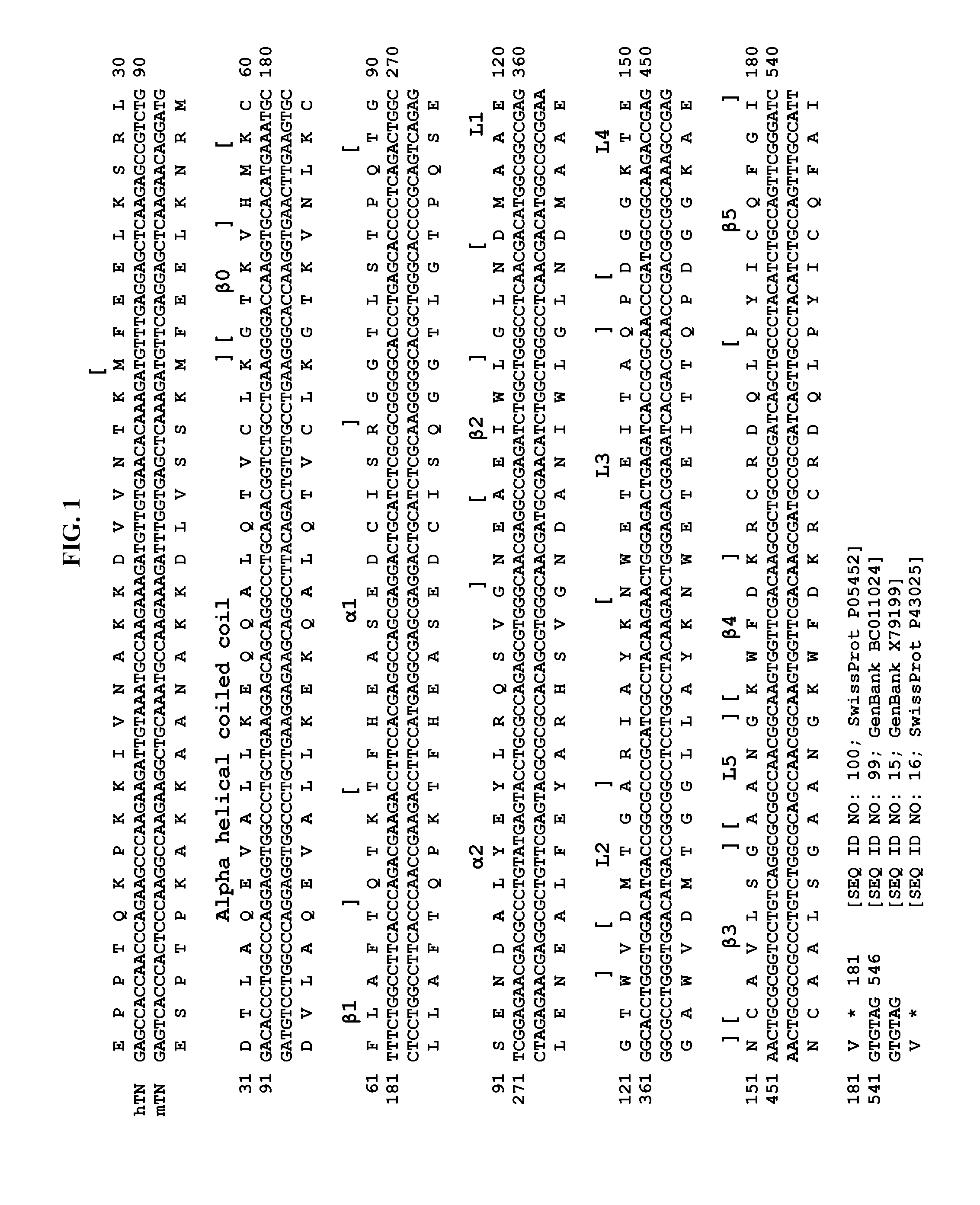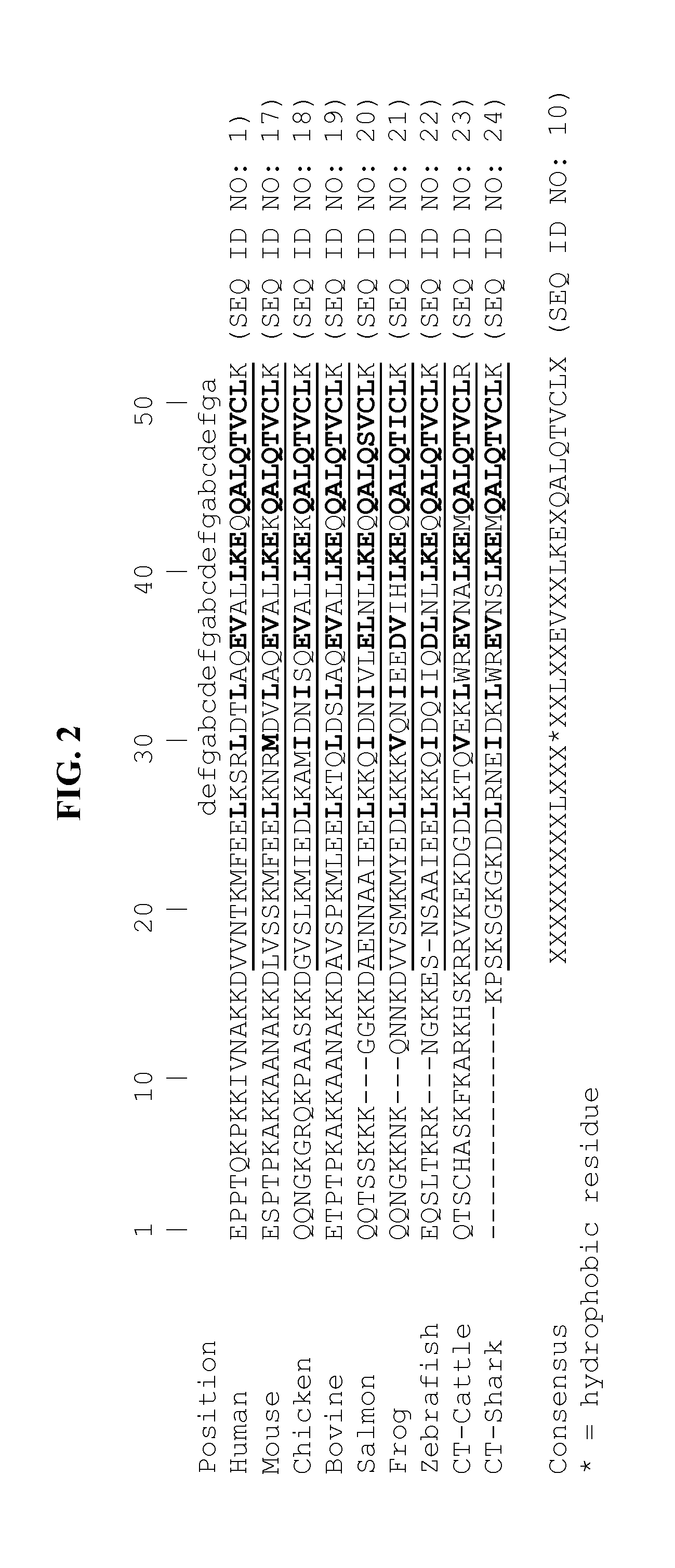Polypeptides that Bind TRAIL-R1 and TRAIL-R2
a polypeptide and polypeptide technology, applied in the field of cancer and other disorders, can solve the problems of short half-life, large size of antibodies can limit tumor penetration, and short half-life,
- Summary
- Abstract
- Description
- Claims
- Application Information
AI Technical Summary
Problems solved by technology
Method used
Image
Examples
example 1
Library Construction
Mutation and Extension of Loop 1
[0194]The sequence of human tetranectin and the positions of loops 1, 2, 3, 4 (LSA), and 5 (LSB) are shown in FIGS. 1 and 4. For the 1-2 extended libraries of human tetranectin C-type lectin binding domains (“Human 1-2X”), the coding sequences for Loop 1 were modified to encode the sequences shown in Table 2, where the five amino acids AAEGT (SEQ ID NO: 176); human) were substituted with seven random amino acids encoded by the nucleotides NNK NNK NNK NNK NNK NNK NNK (SEQ ID NO: 177); N denotes A, C, G, or T; K denotes G or T. The amino acid arginine immediately following Loop 2 was also fully randomized by using the nucleotides NNK in the coding strand. This amino acid was randomized because the arginine contacts amino acids in Loop 1, and might constrain the configurations attainable by Loop 1 randomization. In addition, the coding sequence for Loop 4 was altered to encode an alanine (A) instead of the lysine (K) in order to abrog...
example 2
Library Construction
Mutation of Loops 1 and 2
[0197]For the Loop 1-2 libraries of human and mouse tetranectin C-type lectin binding domains (“Human 1-2”), the coding sequences for Loop 1 were modified to encode the sequences shown in Table 2, where the five amino acids AAEGT (SEQ ID NO: 176; human) were replaced with five random amino acids encoded by the nucleotides NNK NNK NNK NNK NNK ((SEQ ID NO: 247); N denotes A, C, G, or T; K denotes G or T). In Loop 2 (including the neighboring arginine), the four amino acids TGAR in human were replaced with four random amino acids encoded by the nucleotides NNK NNK NNK NNK (SEQ ID NO: 248). In addition, the coding sequence for Loop 4 was altered to encode an alanine (A) instead of the lysine (K) in the loop, in order to abrogate plasminogen binding, which has been shown to be dependent on the Loop 4 lysine (Graversen et al., 1998).
[0198]The human 1-2 library was generated using overlap PCR in the following manner (primer sequences are shown i...
example 3
Library Construction
Mutation and Extension of Loops 1 and 4
[0199]For the Loop 1-4 library of human C-type lectin binding domains (“Human 1-4”), the coding sequences for Loop 1 were modified to encode the sequences shown in Table 2, where the seven amino acids DMAAEGT (SEQ ID NO: 249) were substituted with seven random amino acids encoded by the nucleotides NNS NNS NNS NNS NNS NNS NNS (SEQ ID NO: 250) (N denotes A, C, G, or T; S denotes G or C; K denotes G or T). In addition, the coding sequences for Loop 4 were modified and extended to encode the sequences shown in Table 2, where two amino acids of Loop 4, KT were replaced with five random amino acids encoded by the nucleotides NNS NNS NNS NNS NNS (SEQ ID NO: 251) for human or NNK NNK NNK NNK NNK (SEQ ID NO: 247) for mouse.
[0200]The human 1-4 library was generated using overlap PCR in the following manner (primer sequences are shown in Table 3). Primers BglBssfor (SEQ ID NO: 215) and BssBglrev (SEQ ID NO: 216) were mixed and extende...
PUM
| Property | Measurement | Unit |
|---|---|---|
| Fraction | aaaaa | aaaaa |
| Volume | aaaaa | aaaaa |
| Volume | aaaaa | aaaaa |
Abstract
Description
Claims
Application Information
 Login to View More
Login to View More - R&D
- Intellectual Property
- Life Sciences
- Materials
- Tech Scout
- Unparalleled Data Quality
- Higher Quality Content
- 60% Fewer Hallucinations
Browse by: Latest US Patents, China's latest patents, Technical Efficacy Thesaurus, Application Domain, Technology Topic, Popular Technical Reports.
© 2025 PatSnap. All rights reserved.Legal|Privacy policy|Modern Slavery Act Transparency Statement|Sitemap|About US| Contact US: help@patsnap.com



